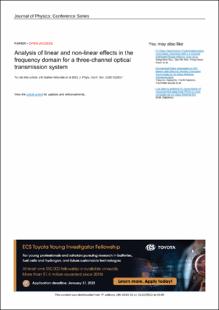Analysis of linear and non-linear effects in the frequency domain for a three-channel optical transmission system
Artículo de revista
2021-08-26
This paper presents the analysis of a wavelength division multiplexer communication system in the frequency domain, with the objective of visualizing the incidence of the linear phenomena of attenuation and chromatic dispersion, together with the phenomenon of phase
self-modulation, the Kerr electro-optical effect and fourth wave mixing. The analyzed system consists of a laser transmitter with a Mach-Zender modulator and a standard G.625b single-mode fiber link transmitting three optical signals of 10 mW, 25 mW and 50 mW at a fundamental wavelength of 1550 nm at a rate of 10 Gbps. This system is analyzed through a graphical user interface programmed by the authors in the Python environment, which calculates the parameters
corresponding to each phenomenon and graphically represents the transmission results at distances of 50 km and 100 km. The analysis methodology consists of varying the spectral separation of the transmitted channels, initially considering a spectral separation of 2 nm and subsequently a spectral separation of 0.2 nm, observing as a result that the harmonics generated by the fourth wave mixing phenomenon considerably alter the spectral density of the transmitted
signals, since the energy of the harmonics is equal to the power of the transmitted signals. On the other hand, with the spectral spacing of 0.2 nm, it is obtained that, although the harmonics alter the spectral density waveform, the bandwidth is not compromised by these additional signals.
Descripción:
Main article
Título: Galvis-Velandia_2021_J._Phys.__Conf._Ser._2102_012017.pdf
Tamaño: 1.275Mb
 PDF
PDF
 LEER EN FLIP
LEER EN FLIP
Título: Galvis-Velandia_2021_J._Phys.__Conf._Ser._2102_012017.pdf
Tamaño: 1.275Mb
 PDF
PDF
 LEER EN FLIP
LEER EN FLIP

















